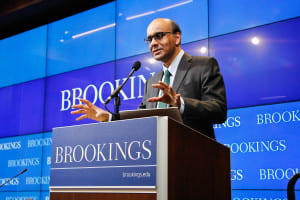
Singapore’s Deputy Prime Minister Tharman Shanmugaratnam offered insights on Singapore’s use of housing policy and urban planning as levers for stability and social inclusion during a recent event at Brookings Institution in Washington, D.C.
He was the keynote speaker at “Housing, Inclusion and Social Equity: An International and US Perspective,” where scholars and policymakers gathered Nov. 30 to discuss policies and practices, Washington University in St. Louis (WashU), Brookings Institution, Duke University, and the National University of Singapore sponsored the event.
Housing and neighborhoods directly affect racial inclusion and social equity. When housing and neighborhood policies and design are not inclusive, many nations face the challenge of promoting economic opportunity and social mobility.
The event at Brookings Institution featured experts from the United Kingdom, Singapore, India, and the United States, who offered comparisons and policy insights.
Singapore’s case is distinctive for creating widespread homeownership and integration by ethnicity and religion. Shanmugaratnam pointed out that in his country “we’ve always thought … in terms of economic and social policies intertwined.”
The homeownership rate in Singapore is 90 percent, compared with 65 percent in the United States and the United Kingdom. “The essential point is the lower-income group has not been left out in… the accumulation of home equity,” he said.
Shanmugaratnam has previously served as Education Minister, and as Finance Minister. In October 2015, he was appointed Coordinating Minister for Economic and Social Policies. In addition, he is chairman of the Monetary Authority of Singapore, Singapore’s central bank.
“The secret sauce is our neighborhoods,” he said. They are carefully designed and planned to maximize interaction and to give Singapore the best chance of an integrated society, he said. “It’s about the everyday experiences that come about because of the design.”
Currently, eight in ten Singaporean households have a park within a ten-minute walk, he said, and that number will increase to nine in ten by 2030. The parks are “quality spaces for young and old, regardless of your social status.”
Singapore’s “most intrusive social policy” is a set of rules that ensure no neighborhood develops a large ethnic concentration, he said. “That’s what’s held our society together,” he said, noting that people of different ethnicities, religions and economic status interact every day, and that their children grow up together.
“Multiculturalism is a source of pride” in Singapore, he said, and a source of peace.
Michael Sherraden, the George Warren Brown Distinguished University Professor at Washington University and director of the Next Age Institute at the university, introduced Shanmugaratnam. In the United States, Sherraden said, “if we don’t figure out residence and race, our prospects don’t look that good.”
Neighborhoods full of poverty lead to “very poor outcomes in general for the children we want to raise for the next generation,” he said, yet the U.S. has not delved deeply into addressing such problems.
David Conner, Retired CEO and Director, Oversea-Chinese Banking Corporation (OCBC), and a member of Board of Trustees at WUSTL, responded to Shanmugaratnam’s keynote speech by relating how OCBC partnered with the Housing Development Board (HDB) in financing public housing. “The Lesson is very clear: public and private partnership can work and can be quite effective”, Conner said.
James V. Wertsch, Washington University’s David R. Francis Distinguished Professor, vice chancellor for international affairs and professor of anthropology, also welcomed the crowd on behalf of Washington University.
“Today is an example of how we can look at housing equity as an issue that exists not only in the United States … and the ways that we can come together with better solutions maybe for places everywhere.”
A video of the event is available here, as are the speakers’ PowerPoint presentations.